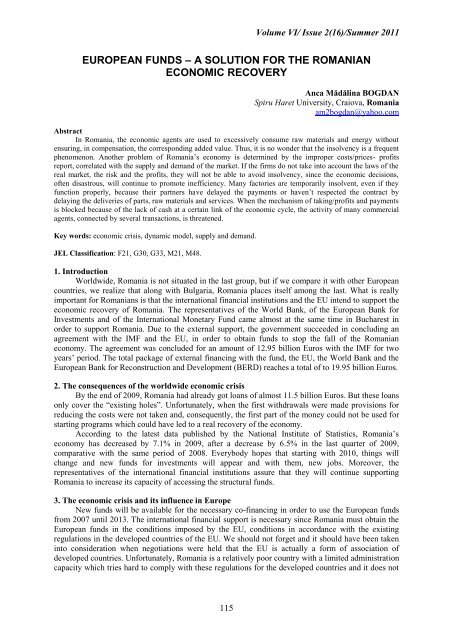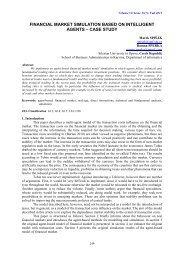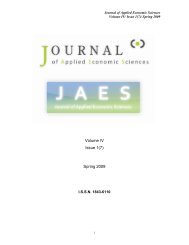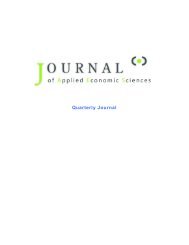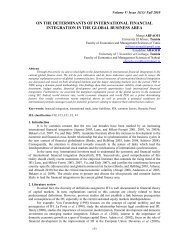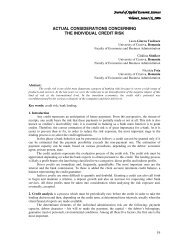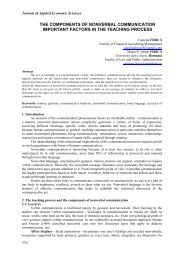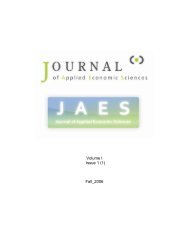european funds â a solution for the romanian economic recovery
european funds â a solution for the romanian economic recovery
european funds â a solution for the romanian economic recovery
Create successful ePaper yourself
Turn your PDF publications into a flip-book with our unique Google optimized e-Paper software.
Volume VI/ Issue 2(16)/Summer 2011<br />
EUROPEAN FUNDS – A SOLUTION FOR THE ROMANIAN<br />
ECONOMIC RECOVERY<br />
Anca Mădălina BOGDAN<br />
Spiru Haret University, Craiova, Romania<br />
am2bogdan@yahoo.com<br />
Abstract<br />
In Romania, <strong>the</strong> <strong>economic</strong> agents are used to excessively consume raw materials and energy without<br />
ensuring, in compensation, <strong>the</strong> corresponding added value. Thus, it is no wonder that <strong>the</strong> insolvency is a frequent<br />
phenomenon. Ano<strong>the</strong>r problem of Romania’s economy is determined by <strong>the</strong> improper costs/prices- profits<br />
report, correlated with <strong>the</strong> supply and demand of <strong>the</strong> market. If <strong>the</strong> firms do not take into account <strong>the</strong> laws of <strong>the</strong><br />
real market, <strong>the</strong> risk and <strong>the</strong> profits, <strong>the</strong>y will not be able to avoid insolvency, since <strong>the</strong> <strong>economic</strong> decisions,<br />
often disastrous, will continue to promote inefficiency. Many factories are temporarily insolvent, even if <strong>the</strong>y<br />
function properly, because <strong>the</strong>ir partners have delayed <strong>the</strong> payments or haven’t respected <strong>the</strong> contract by<br />
delaying <strong>the</strong> deliveries of parts, raw materials and services. When <strong>the</strong> mechanism of taking/profits and payments<br />
is blocked because of <strong>the</strong> lack of cash at a certain link of <strong>the</strong> <strong>economic</strong> cycle, <strong>the</strong> activity of many commercial<br />
agents, connected by several transactions, is threatened.<br />
Key words: <strong>economic</strong> crisis, dynamic model, supply and demand.<br />
JEL Classification: F21, G30, G33, M21, M48.<br />
1. Introduction<br />
Worldwide, Romania is not situated in <strong>the</strong> last group, but if we compare it with o<strong>the</strong>r European<br />
countries, we realize that along with Bulgaria, Romania places itself among <strong>the</strong> last. What is really<br />
important <strong>for</strong> Romanians is that <strong>the</strong> international financial institutions and <strong>the</strong> EU intend to support <strong>the</strong><br />
<strong>economic</strong> <strong>recovery</strong> of Romania. The representatives of <strong>the</strong> World Bank, of <strong>the</strong> European Bank <strong>for</strong><br />
Investments and of <strong>the</strong> International Monetary Fund came almost at <strong>the</strong> same time in Bucharest in<br />
order to support Romania. Due to <strong>the</strong> external support, <strong>the</strong> government succeeded in concluding an<br />
agreement with <strong>the</strong> IMF and <strong>the</strong> EU, in order to obtain <strong>funds</strong> to stop <strong>the</strong> fall of <strong>the</strong> Romanian<br />
economy. The agreement was concluded <strong>for</strong> an amount of 12.95 billion Euros with <strong>the</strong> IMF <strong>for</strong> two<br />
years’ period. The total package of external financing with <strong>the</strong> fund, <strong>the</strong> EU, <strong>the</strong> World Bank and <strong>the</strong><br />
European Bank <strong>for</strong> Reconstruction and Development (BERD) reaches a total of to 19.95 billion Euros.<br />
2. The consequences of <strong>the</strong> worldwide <strong>economic</strong> crisis<br />
By <strong>the</strong> end of 2009, Romania had already got loans of almost 11.5 billion Euros. But <strong>the</strong>se loans<br />
only cover <strong>the</strong> “existing holes”. Un<strong>for</strong>tunately, when <strong>the</strong> first withdrawals were made provisions <strong>for</strong><br />
reducing <strong>the</strong> costs were not taken and, consequently, <strong>the</strong> first part of <strong>the</strong> money could not be used <strong>for</strong><br />
starting programs which could have led to a real <strong>recovery</strong> of <strong>the</strong> economy.<br />
According to <strong>the</strong> latest data published by <strong>the</strong> National Institute of Statistics, Romania’s<br />
economy has decreased by 7.1% in 2009, after a decrease by 6.5% in <strong>the</strong> last quarter of 2009,<br />
comparative with <strong>the</strong> same period of 2008. Everybody hopes that starting with 2010, things will<br />
change and new <strong>funds</strong> <strong>for</strong> investments will appear and with <strong>the</strong>m, new jobs. Moreover, <strong>the</strong><br />
representatives of <strong>the</strong> international financial institutions assure that <strong>the</strong>y will continue supporting<br />
Romania to increase its capacity of accessing <strong>the</strong> structural <strong>funds</strong>.<br />
3. The <strong>economic</strong> crisis and its influence in Europe<br />
New <strong>funds</strong> will be available <strong>for</strong> <strong>the</strong> necessary co-financing in order to use <strong>the</strong> European <strong>funds</strong><br />
from 2007 until 2013. The international financial support is necessary since Romania must obtain <strong>the</strong><br />
European <strong>funds</strong> in <strong>the</strong> conditions imposed by <strong>the</strong> EU, conditions in accordance with <strong>the</strong> existing<br />
regulations in <strong>the</strong> developed countries of <strong>the</strong> EU. We should not <strong>for</strong>get and it should have been taken<br />
into consideration when negotiations were held that <strong>the</strong> EU is actually a <strong>for</strong>m of association of<br />
developed countries. Un<strong>for</strong>tunately, Romania is a relatively poor country with a limited administration<br />
capacity which tries hard to comply with <strong>the</strong>se regulations <strong>for</strong> <strong>the</strong> developed countries and it does not<br />
115
Volume VI/ Issue 2(16)/Summer 2011<br />
always succeed. Nei<strong>the</strong>r <strong>the</strong> EU, nor Romania is to be blamed <strong>for</strong> this situation. It is actually a<br />
discrepancy between what is expected of a state-member and what Romania can really accomplish.<br />
The structural <strong>funds</strong> are very necessary in <strong>the</strong> logistics and <strong>the</strong> infrastructure of <strong>the</strong><br />
transportation. A study of <strong>the</strong> World Bank shows that an advanced logistics field can increase <strong>the</strong> GDP<br />
of a country by 1% and <strong>the</strong> volume of international trade by 2%. So far, although Romania has<br />
benefitted from European <strong>funds</strong> <strong>for</strong> building highways, it has failed.<br />
Unlike Romania, Croatia – a smaller country which is not an EU member yet – has already got<br />
an incredible road transportation network. The Croatian government has had a better management of<br />
<strong>the</strong> <strong>funds</strong> and of <strong>the</strong> projects. The improvement of <strong>the</strong> road infrastructure will increase <strong>the</strong> chances <strong>for</strong><br />
more <strong>for</strong>eign <strong>economic</strong> agents to come in Romania and <strong>for</strong> <strong>the</strong> Romanian market to become more<br />
interesting and attractive. The <strong>economic</strong> <strong>for</strong>ecast of <strong>the</strong> IMF <strong>for</strong> Romania anticipates a 4.6% decrease<br />
of <strong>the</strong> GDP <strong>for</strong> this year. The <strong>for</strong>ecast has been accepted by our government in discussing <strong>the</strong> budget<br />
<strong>for</strong> 2009 and this led to a cutting of <strong>the</strong> sums earmarked <strong>for</strong> all <strong>the</strong> ministries, except those <strong>for</strong> <strong>the</strong><br />
Ministry of Labour and Social Protection. Nine out of ten entrepreneurs were struck by <strong>the</strong> <strong>economic</strong><br />
crisis while 55% of managers and professionals were affected. “The percentage will seriously increase<br />
among <strong>the</strong> employees working in <strong>the</strong> higher education system and not only <strong>the</strong>re, but due to <strong>the</strong><br />
cutting down of salaries in <strong>the</strong> budgeting system”, stated by M. Chivu, executive at Mercury Research.<br />
Even those who <strong>for</strong> <strong>the</strong> time being do not have a job were strongly affected: 95% of <strong>the</strong>m have<br />
felt <strong>the</strong> impact. On <strong>the</strong> o<strong>the</strong>r hand, 66% of Romanians are more worried by <strong>the</strong>ir financial situation<br />
than <strong>the</strong>y were six months ago, <strong>the</strong> percentage still being lower than <strong>the</strong> one in March 2009 (75%), but<br />
higher than that in November 2008, when <strong>the</strong> first signs of <strong>the</strong> <strong>economic</strong> crisis appeared in Romania<br />
and when only 53% expressed <strong>the</strong>ir fear. The main worries <strong>the</strong>y have had concern with <strong>the</strong><br />
impossibility of maintaining <strong>the</strong> same living standard as in <strong>the</strong> present (40%), with <strong>the</strong> decrease of<br />
<strong>the</strong>ir incomes (39%) or by <strong>the</strong> uncertainty of coping with <strong>the</strong> current expenses (38%).<br />
The worries concerning <strong>the</strong> impossibility to pay <strong>the</strong> installments are also valid <strong>for</strong> 15% of<br />
Romanians over 18 and 14% are afraid that <strong>the</strong>y will not be able to save or invest as <strong>the</strong>y did in <strong>the</strong><br />
previous years. As <strong>for</strong> <strong>the</strong> evolution of <strong>the</strong> financial stability of <strong>the</strong> banks in <strong>the</strong> next semester, <strong>the</strong><br />
percentage of those who consider that <strong>the</strong> situation will be worse has decreased compared with that of<br />
<strong>the</strong> last year, from 61% to 40%. More than a quarter of respondents estimate that <strong>the</strong> financial stability<br />
of <strong>the</strong> banks will be <strong>the</strong> same next semester and 13% consider that it will even increase. These data are<br />
part of The Financial Crisis Meter Survey made by Mercury Research, beginning with <strong>the</strong> 15 th of<br />
March and <strong>the</strong> 1 st of April 2010, on a sample of 1.177 of age respondents.<br />
Romania’s GDP recorded a major correction of 7.2% in 2009, after <strong>the</strong> record level of 126.4<br />
billion Euros in <strong>the</strong> previous year, by 7.1% over <strong>the</strong> figures recorded in 2007. That was <strong>the</strong> first annual<br />
decrease since 1999. The nominal GDP had increased three times since 1999.<br />
The National Institute of Statistics announced that Romania recorded an inflation rate of 0.56%<br />
in September as compared with <strong>the</strong> same period of <strong>the</strong> previous year or <strong>the</strong> background of high prices<br />
<strong>for</strong> goods and services. In January, <strong>the</strong> direct <strong>for</strong>eign investments in Romania amounted to 302 million<br />
Euros, i.e. a decrease by 67% as compared to January 2009. Last year, <strong>the</strong> direct <strong>for</strong>eign investments<br />
amounted to 4.9 billion Euros after <strong>the</strong>y had reached <strong>the</strong> highest level <strong>the</strong> past December period, i.e.<br />
over 9 billion Euros. The long and middle term external debt of Romania “burst” in 2009, increasing<br />
by over 14 billion Euros on <strong>the</strong> whole year, up to 64.2 billion Euros at <strong>the</strong> end of <strong>the</strong> year. In January,<br />
<strong>the</strong> long and middle term external debt remained at <strong>the</strong> same level as in December, while <strong>the</strong> short<br />
term debt decreased by 5.5% up to 13.65 billion Euros.<br />
The increase of <strong>the</strong> public debt appeared in <strong>the</strong> background of <strong>the</strong> decrease of <strong>the</strong> incomes in <strong>the</strong><br />
state budget, which <strong>for</strong>ced <strong>the</strong> government to borrow heavily in order to comply with its obligations.<br />
The increase of <strong>the</strong> prices <strong>for</strong> consumption surpassed <strong>the</strong> analysts’ <strong>for</strong>ecast, i.e. an annual<br />
inflation of 7.6%. The unemployment recorded again an increasing trend beginning with <strong>the</strong> second<br />
half of 2008, and lately <strong>the</strong> rate of unemployment has increased by 0.2 – 0.3% every month. In<br />
February, <strong>the</strong> unemployment rate reached 8.3% as compared with 8.1% in January and 7.8% at <strong>the</strong> end<br />
of <strong>the</strong> last year. The exports have grown with 19.8% (Euros) in January as compared with <strong>the</strong> same<br />
month in 2009, up to 2.3 billion Euros, thus continuing <strong>the</strong> upward trend started in last November.<br />
In <strong>the</strong> first three quarters of 2010, as compared to <strong>the</strong> corresponding period of <strong>the</strong> previous year,<br />
<strong>the</strong> gross index of <strong>the</strong> industrial production was greater with 5.2%, a growth increase determined by<br />
116
Volume VI/ Issue 2(16)/Summer 2011<br />
two out of three industrial sectors: <strong>the</strong> supply of electricity, heat, gas, hot water and air conditioning<br />
production and supply (+9.4%) and <strong>the</strong> processing industry (+5.5%), aspects presented in Figure1.<br />
Thus, in <strong>the</strong> mining industry, <strong>the</strong> output decreased by 7.7%, and in <strong>the</strong> manufacturing industry,<br />
<strong>the</strong> most important increases were recorded in <strong>the</strong> following branches: <strong>the</strong> automobiles, trailer and<br />
semi-trailer manufacture, electric equipment manufacturer (+33.4% each) and <strong>the</strong> metallurgical<br />
industry (+33.2%). Significant decreases of <strong>the</strong> production in <strong>the</strong> processing industry were recorded in<br />
o<strong>the</strong>r means of transportation manufacture (-34.6%), cigarette manufacture (-22.7%) and in <strong>the</strong> o<strong>the</strong>r<br />
industrial activities (-16.6%). On <strong>the</strong> large industrial groups, increases of <strong>the</strong> output have been<br />
obtained in: intermediary goods industry (+9.9%), capital goods industry (+9.0%) and energy industry<br />
(+3.9%). In <strong>the</strong> household goods industry and in <strong>the</strong> durable goods industry, <strong>the</strong> production decreased<br />
by 4.4%, respectively by 1.9%.<br />
Figure 1. Industrial volume index of output from September 2009 until September 2010 - gross series -<br />
The turnover of retail trade firms decreased in January, as an adjusted series, depending on <strong>the</strong><br />
number of black-letter days and season, by 10.3%, as compared to January 2009.<br />
The decrease of retail returned to two figures level after <strong>the</strong> last months of <strong>the</strong> previous year<br />
when <strong>the</strong> rhythm of adjustment of <strong>the</strong> trade turnover had started to flatten.<br />
The following indices of turnover in <strong>the</strong> industry were reached in September 2010 as compared<br />
with <strong>the</strong> corresponding period of <strong>the</strong> previous year: <strong>the</strong> total value index of <strong>the</strong> turnover in <strong>the</strong> industry<br />
(domestic and external market) rose to 10.8%, due to <strong>the</strong> manufacturing industry (+11.7%) and in <strong>the</strong><br />
mining industry turnover has decreased by 7.3% (Figure 2).<br />
Thus in <strong>the</strong> manufacturing industry, <strong>the</strong> most significant increases of <strong>the</strong> total turnover were in<br />
<strong>the</strong> following branches: metallurgical industry (+45.9%), computers, electronic components and optic<br />
products manufacture (+36.7%), automobile, trailers and semi-trailers manufacture (+30.1%), coking<br />
products manufacture and refined petroleum products manufacture (+24.9%).<br />
117
Volume VI/ Issue 2(16)/Summer 2011<br />
Figure 2. The value index of <strong>the</strong> industrial turnover between September 2009 and September 2010<br />
We can also mention important decreases of <strong>the</strong> total turnover <strong>for</strong> <strong>the</strong> industrial branches:<br />
o<strong>the</strong>r means of transportation manufacture (-19.7%), <strong>the</strong> repair, maintenance and installation of <strong>the</strong><br />
machines and equipment (-19.2%), <strong>the</strong> manufacturing of tobacco-based products (-14.3%), o<strong>the</strong>r<br />
industrial related activities (-7.5%) and alcohol production (-6.3%). On <strong>the</strong> large industrial groups, we<br />
note <strong>the</strong> increase of <strong>the</strong> total turnover in <strong>the</strong> following branches: <strong>the</strong> capital goods industry (+17.6%),<br />
followed by <strong>the</strong> energy industry (+16.3%), intermediary goods industry (+13.8%) and durable goods<br />
industry (+5.3%). In <strong>the</strong> household goods industry, <strong>the</strong> turnover decreased by 0.1%.<br />
In December, <strong>the</strong> volume of construction works diminished, as an adjusted series, by 13.1%<br />
depending on <strong>the</strong> black-litter days and <strong>the</strong> season, as compared to <strong>the</strong> recorded level in <strong>the</strong> same<br />
period of <strong>the</strong> last year. The construction field has been one of <strong>the</strong> most affected by <strong>the</strong> present<br />
<strong>economic</strong> crisis. The labour market has also changed. The number of employees in industry (in <strong>the</strong><br />
<strong>economic</strong> agents with more than four employees) was 1,213,600 in September 2010, by 0.200 more<br />
than in August 2010. The most of <strong>the</strong>m, 980,900 are employed in <strong>the</strong> manufacturing industry,<br />
followed by water supply sanitation, waste management, remediation activities, 95,900 employees, <strong>the</strong><br />
production and supply of electricity, heat, gas, hot water and air conditioning with 72,500 persons and<br />
by <strong>the</strong> mining industry with 64,300 employees. In <strong>the</strong> industrial branches, <strong>the</strong> food industry plans on<br />
<strong>the</strong> first place with 144,900 persons followed by clothing manufacture with 142,000 and automobiles,<br />
road vehicles, trailers and semi-trailers with 118,000 employees.<br />
The average gross salary in industry was 1953 lei in September 2010 and <strong>the</strong> net one – 1419 lei,<br />
i.e. an increase as compared to August 2010 (+1.1%) – see Figure 3 and also as compared to<br />
September 2009 (+6.6%).<br />
Figure 3. The average gross salary in <strong>the</strong> industry sector in September 2010<br />
118
Volume VI/ Issue 2(16)/Summer 2011<br />
The highest average gross salary has been recorded in <strong>the</strong> electricity, gas, heat and air<br />
conditioning production and supply industry – 3,471 lei, followed by 4,045 lei in <strong>the</strong> mining industry<br />
and by <strong>the</strong> processing industry with 1,714 lei. The lowest salary had been recorded in <strong>the</strong> following<br />
branches: clothing manufacture – 1,134 lei, woodworking, manufacture of wood and cork products,<br />
except <strong>for</strong> <strong>the</strong> furniture; straw products manufacture and o<strong>the</strong>r industrial plants manufacture – 1,156<br />
lei and lea<strong>the</strong>r manufacture, lea<strong>the</strong>r tanning voyage products and morocco lea<strong>the</strong>r goods manufacture,<br />
harness, footwear manufacture, dyed furs manufacture – 1,218 lei. The lowest average gross salary of<br />
1,705 lei was in <strong>the</strong> sector of water supply, sanitation, and waste management and remediation<br />
activities.<br />
The lei-euro currency rates of exchange have settled between 4.2 – 4.3 lei in <strong>the</strong> last months of<br />
<strong>the</strong> previous year. In <strong>the</strong> last part of <strong>the</strong> year and in <strong>the</strong> first months of 2009, <strong>the</strong> value of <strong>the</strong> euro<br />
increased rapidly, exceeding <strong>the</strong> rate of 4 lei/euro.<br />
At <strong>the</strong> beginning of 2010, our currency became stronger and <strong>the</strong> rate fluctuated between 4.1 –<br />
4.15 lei/euro, compared to an average of 4.22 lei in <strong>the</strong> year be<strong>for</strong>e. The US dollar has had an<br />
increasing trend lately, reaching up to 3 lei.<br />
There could be <strong>solution</strong>s <strong>for</strong> all <strong>the</strong>se deficits but in order to apply <strong>the</strong>m, Romania needs time.<br />
The lack of anti-crisis measures leads to a deepening of <strong>the</strong> situation. Thus, applying financial taxes at<br />
<strong>the</strong> level of <strong>the</strong> European and global nations would fur<strong>the</strong>r contribute to solve o<strong>the</strong>r problems<br />
(cooperation <strong>for</strong> development, <strong>the</strong> fight against wea<strong>the</strong>r changes) and would help <strong>the</strong> economy<br />
worldwide recover.<br />
The proposal concerns two type of taxes: <strong>the</strong> first one applied to <strong>the</strong> financial activities, on <strong>the</strong><br />
whole European sector and <strong>the</strong> second one applied to international financial transactions. Since <strong>the</strong><br />
banks and o<strong>the</strong>r companies which supply financial services have had an important role in <strong>the</strong><br />
beginning of <strong>the</strong> crisis and since <strong>the</strong>y have benefitted from a considerable support from <strong>the</strong><br />
government of state-members <strong>the</strong>se last two years, <strong>the</strong> tax would act as a contribution of <strong>the</strong> financial<br />
system to <strong>the</strong> <strong>economic</strong> <strong>recovery</strong>.<br />
On <strong>the</strong> o<strong>the</strong>r hand, compared to o<strong>the</strong>r sectors of <strong>the</strong> economy, <strong>the</strong> financial sector has fewer<br />
taxes to pay. For example, many banks are exempt from <strong>the</strong> value added tax and benefit from o<strong>the</strong>r<br />
various preferential advantages. The incomes thus obtained could be deposited as a fair contribution to<br />
<strong>the</strong> state budget.<br />
Meanwhile, <strong>the</strong> introduction of an international tax on financial transactions would act as a<br />
means of generating new incomes. These could be used to finance global policies, <strong>for</strong> instance <strong>the</strong> aid<br />
<strong>for</strong> development and <strong>the</strong> fight against wea<strong>the</strong>r changes.<br />
The European Commission will evaluate <strong>the</strong> impact of such a tax on <strong>the</strong> economy. If <strong>the</strong> effects<br />
of <strong>the</strong> crisis are not reduced in “<strong>the</strong> next period, <strong>the</strong> major risks <strong>for</strong> Romania consist in little deviations<br />
from <strong>the</strong> measures and goals stipulated in <strong>the</strong> agreement with <strong>the</strong> IMF, especially <strong>the</strong> admitted<br />
maximum budgetary deficit on 2010, i.e. 5.9% of GDP and respectively <strong>the</strong> goals established <strong>for</strong> each<br />
quarter”, stated by Baltavan. A new agreement with <strong>the</strong> IMF is “absolutely necessary” in order to<br />
facilitate Romania’s access on <strong>the</strong> European bonds market. “The money thus obtained will be used to<br />
cover <strong>the</strong> budgetary deficit and to pay <strong>the</strong> present loan from <strong>the</strong> fund”.<br />
4. Conclusions<br />
Some American economists, analysts and journalists have made a study referring to <strong>the</strong> different<br />
effects of <strong>the</strong> <strong>economic</strong> crisis on women and men. The results showed that women have coped better<br />
with <strong>the</strong> crisis’ effects.<br />
The similar results were obtained in Europe, USA, Asia and South America and <strong>the</strong>se led<br />
journalists to entitle <strong>the</strong> current crisis – “<strong>the</strong> mancession”. Many analysts reached <strong>the</strong> same conclusion<br />
and so <strong>the</strong> term “mancession” – used to define <strong>the</strong> phenomenon – has entered <strong>the</strong> common language.<br />
Why are men more affected by <strong>the</strong> crisis? Statistics have shown that men are more affected than<br />
women. Romanian women have saved <strong>the</strong>ir families during <strong>the</strong> crisis. The EU’s statistics show that<br />
75% of <strong>the</strong> jobs created since 2005 have been occupied by women, one of <strong>the</strong> reasons being that in<br />
90% of cases, women are better paid.<br />
Analysts consider that so far <strong>the</strong> agreement with <strong>the</strong> IMF has been <strong>the</strong> real anti-crisis measures<br />
taken by <strong>the</strong> government. As <strong>for</strong> <strong>the</strong> anti-crisis plan applied so far by <strong>the</strong>m, this has been nothing, but a<br />
political action strictly <strong>for</strong>mal without positive effects on <strong>the</strong> economy. Up to now, <strong>the</strong> state’s action<br />
119
Volume VI/ Issue 2(16)/Summer 2011<br />
has been inefficient since most of <strong>the</strong> measures could not be applied. The cutting down of <strong>the</strong><br />
expenses? The public officers and o<strong>the</strong>r savings must be used <strong>for</strong> important investments, and not <strong>for</strong><br />
o<strong>the</strong>r acquisitions.<br />
The state’s intervention in <strong>the</strong> <strong>economic</strong> <strong>recovery</strong> has been ra<strong>the</strong>r inefficient so far. The crisis<br />
started in <strong>the</strong> private sector and this brought ahead <strong>the</strong> great current account deficit. We cannot ask <strong>the</strong><br />
state to restructure <strong>the</strong> private sector. Both in <strong>the</strong> private as well as in <strong>the</strong> public sector we can<br />
conclude that <strong>the</strong>y both need an adjustment to decrease <strong>the</strong> effects triggered and that measures <strong>for</strong> <strong>the</strong>ir<br />
<strong>recovery</strong> are not yet possible.<br />
The authorities’ plan focused on <strong>the</strong> cutting down of <strong>the</strong> expenses and <strong>the</strong> structural re<strong>for</strong>ms too<br />
have actually had monetary goals: to reduce <strong>the</strong> expenses <strong>for</strong> salaries and retirements. This plan can<br />
help to decrease <strong>the</strong> deficit and to finance it but it cannot be a support <strong>for</strong> <strong>the</strong> <strong>economic</strong> <strong>recovery</strong>. On<br />
<strong>the</strong> contrary, on <strong>the</strong> short term <strong>the</strong> cutting down of <strong>the</strong> expenses may deepen <strong>the</strong> crisis, that is why <strong>the</strong><br />
most viable <strong>solution</strong> would be to apply taxes and <strong>the</strong> value added tax (VAT) on <strong>the</strong> incomes of <strong>the</strong><br />
banks too.<br />
References:<br />
[1] Bari, L., Şerbănescu, I. 1985.Global <strong>economic</strong> crisis and <strong>the</strong> problems of youth. Ed.<br />
Bucharest.<br />
[2] Covey, St. 2010. Eficienţa în şapte trepte, Editura ALL, Bucharest, in Romanian.<br />
[3] Dijmărescu, E., Ghibuţiu, A., Isărescu, M., Murgescu, C., Nistorescu, N., Pop, N., Radu, V.,<br />
Titircă, R. 1986. Global <strong>economic</strong> crisis, Scientific and Encyclopedic Publishing House,<br />
Bucharest.<br />
[4] Foster, J.B., Magdoff, F. 2009. The Great Financial Crisis: Causes and Consequences.<br />
Publisher: Monthly Review Press.<br />
[5] George, B. 2009. Seven Lessons <strong>for</strong> Leading in Crisis. Jossey-Bass, San Francisco.<br />
[6] Gust, M., Mihăilescu, M., Puiu, O. 2006. Bodies and international <strong>economic</strong> policy, Ed. Economic<br />
Independence, Pitesti.<br />
[7] Heifetz, R.A. 1994. Leadership without Easy Answers. Harvard Business School Press,<br />
Boston,<br />
[8] Hrebenciuc, A. 2010. Iluzia. Erou şi antierou în crizele <strong>economic</strong>e, Editura Corint,<br />
Bucureşti, in Romania.<br />
[9] Marin, D. 1999. I am Romanian - re<strong>for</strong>m crisis? Economic Publishing House, Bucharest.<br />
[10] Puiu, A. 1983. Contradictory developments in <strong>the</strong> global economy, Bucharest, Political<br />
Publishing House.<br />
[11] Shiller, R. 2008. The subprime <strong>solution</strong>: How today’s global financial crisis happened<br />
and what to do about it, Princeton University Press, New Jersey,<br />
*** Leading through a Crisis (Skills You Need Today), Harvard Business School Press, 2009.<br />
*** Institutul Naţional de Statistică, Buletin Statistic de Industrie, nr. 9\2010.<br />
120


